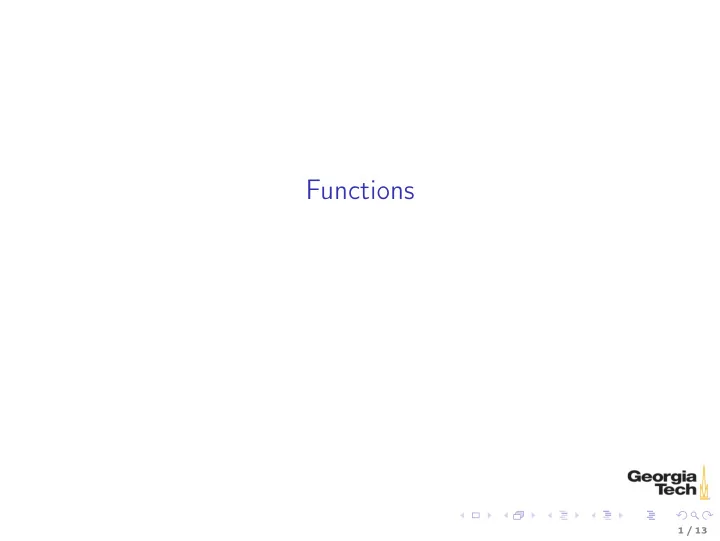

Functions 1 / 13
Functions A function is a reusable block of code. Functions ◮ have names (usually), ◮ contain a sequence of statements, and ◮ return values, either explicitly or implicitly. We’ve already used several built-in functions. Today we will learn how to define our own. 2 / 13
Hello, Functions! We define a function using the def keyword: >>> def say_hello(): ... print (’Hello’) ... (blank line tells Python shell you’re finished defining the function) Once the function is defined, you can call it: >>> say_hello() Hello 3 / 13
Defining Functions The general form of a function definition is def <function_name>(<parameter_list>): <function_body> ◮ The first line is called the header. ◮ function_name is the name you use to call the function. ◮ parameter_list is a list of parameters to the function, which may be empty. ◮ function_body is a sequence of expressions and statements. 4 / 13
Function Parameters Provide a list of parameter names inside the parentheses of the function header, which creates local variables in the function. >>> def say_hello(greeting): ... print (greeting) ... Then call the function by passing arguments to the function: values that are bound to parameter names. Here we pass the value ’Hello’, which is bound to say_hello ’s parameter greeting and printed to the console by the code inside say_hello . >>> say_hello(’Hello’) Hello Here we pass the value ’Guten Tag!’: >>> say_hello(’Guten Tag!’) Guten Tag! 5 / 13
Variable Scope Parameters are local variables. They are not visible outside the function: >>> greeting Traceback (most recent call last): File "<stdin>", line 1, in <module> NameError: name ’greeting’ is not defined Global variables are visible outside the function and inside the function. >>> global_hello = ’Bonjour’ >>> global_hello ’Bonjour’ >>> def say_global_hello(): print (global_hello) ... ... >>> say_global_hello() Bonjour 6 / 13
Redefining and Shadowing A function a kind of variable. If you define a function with the same name as a variable, it re-binds the name, and vice-versa. >>> global_hello = ’Bonjour’ >>> def global_hello(): print (’This is the global_hello() function.’) ... ... >>> global_hello <function global_hello at 0x10063b620> A function parameter with the same name as a global variable shadows the global variable. >>> greeting = ’Hi ya!’ >>> def greet(greeting): ... print (greeting) ... >>> greeting ’Hi ya!’ >>> greet(’Hello’) Hello 7 / 13
Muliple Parameters A function can take any number of parameters. >>> def greet(name, greeting): ... print (greeting + ’, ’ + name) ... >>> greet(’Professor Falken’, ’Greetings’) Greetings, Professor Falken Parameters can be of multiple types. >>> def greet(name, greeting, number): ... print (greeting * number + ’, ’ + name) ... >>> greet(’Professor Falken’, ’Greetings’, 2) GreetingsGreetings, Professor Falken 8 / 13
Positional and Keyword Arguments Thus far we’ve called functions using positional arguments, meaning that argument values are bound to parameters in the order in which they appear in the call. >>> def greet(name, greeting, number): ... print (greeting * number + ’, ’ + name) ... >>> greet(’Professor Falken’, ’Greetings’, 2) We can also call functions with keyword arguments in any order. >>> greet(greeting=’Hello’, number=2, name=’Dolly’) HelloHello, Dolly If you call a function with both positional and keyword arguments, the positional ones must come first. 9 / 13
Default Parameter Values You can specify default parameter values so that you don’t have to provide an argument. >>> def greet(name, greeting=’Hello’): ... print (greeting + ’, ’ + name) ... >>> greet(’Elmo’) Hello, Elmo If you provide an argument for a parameter with a default value, the parameter takes the argument value passed in the call instead of the default value. >>> greet(’Elmo’, ’Hi’) Hi, Elmo 10 / 13
Variable Argument Lists You can collect a variable number of positional arguments as a tuple by preprending a parameter name with * >>> def echo(*args): ... print (args) ... >>> echo(1, ’fish’, 2, ’fish’) (1, ’fish’, 2, ’fish’) You can collect variable keyword arguements as a dictionary with ** >>> def print_dict(**kwargs): print (kwargs) ... ... >>> print_dict(a=1, steak=’sauce’) {’a’: 1, ’steak’: ’sauce’} 11 / 13
Return Values Functions return values. >>> def average(nums): ... return sum (nums) / len (nums) ... >>> average([100, 90, 80]) 90.0 If you don’t explicitly return a value, None is returned implicitly. >>> def g(): ... print ("man") ... >>> fbi = g() man >>> fbi >>> type (fbi) < class ’NoneType’> Functions are expressions like any other. >>> grades_line = [’Chris’, 100, 90, 80] >>> grades = {} >>> grades[grades_line[0]] = average(grades_line[1:]) >>> grades {’Chris’: 90.0} 12 / 13
Inner Functions Information hiding is a general principle of software engineering. If you only need a function in one place, inside another function, you can declare it inside that function so that it is visible only in that function. >>> def factorial(n): ... def fac_iter(n, accum): ... if n <= 1: ... return accum return fac_iter(n - 1, n * accum) ... ... return fac_iter(n, 1) ... >>> factorial(5) 120 fac_iter() is a (tail) recursive function. Recursion is important for computer scientists, but a practically-oriented Python-programming engineer will mostly use iteration, higher-order functions and loops, which are more Pythonic. Any recursive computation can be formulated as an imperative computation. 13 / 13
Recommend
More recommend